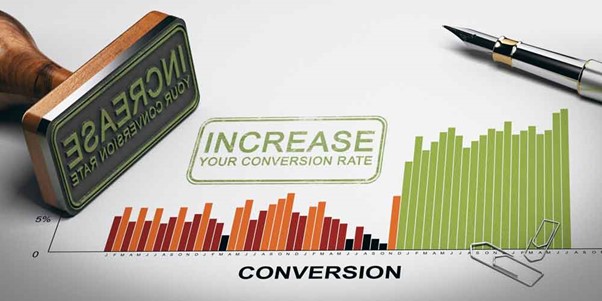CONVERSION RATE OPTIMISATION – CRO
Introduction to CRO
 Your company website design needs to perform two basic functions well.
Your company website design needs to perform two basic functions well.
1: Attract as many relevant site visitors as possible, this is achieved through a range of organic methods, SEO and quality content, as well as various Paid Advertising options.
2: Convert visitors into customers. On average 96% of first-time visitors to a website will bounce off never to return again. It’s imperative to convert as many of these visitors as possible into Leads that can be further nurtured along the buyer’s journey to become paying clients.
While both these processes are essential for success we have greater control and influence over the conversion process.
What is Conversion Rate Optimisation?
Conversion Rate Optimisation is the art of converting visitors on your website into Customers or Leads that can be nurtured into becoming future customers.
We first need to know or define a few metrics in order to know what your Conversion Rate is:
1: How many visitors do we receive on our website each month, we can track this quite easily on Google Analytics.
2: What do we consider to be a Conversion? This could include an actual purchase, an inquiry about your product or services or someone who provides their contact details in exchange for something we offered them on the website like an eBook or free sample. Once we have defined a conversion we need to Tag these in Google Analytics so we can track and count them.
Each of these conversions may have a different value to your company. Naturally, we would all love to make as many sales as possible but it’s unlikely that most first-time visitors to our website will make an actual purchase there and then, most will need some encouragement and nurturing. It requires an average of 7-9 interactions with a company before most people make an actual purchase.
It’s essential to build an email list of website visitors who have expressed an interest in your products or services so we can communicate with them and move them along the Buyer’s Journey to become a client.
Your conversion rate percentage is calculated as;
The Number of Conversions / The Number of Website Visitors x 100, could also be calculated for each of the different conversions separately for more in-depth tracking of your Sales Funnel.
Essentially Conversion Rate Optimisation is all about improving these percentages, converting a higher percentage of website visitors into Leads and Customers.
Contact Us for your Conversion Rate Optimisation Needs
How Conversion Rate Optimisation Works.
Conversion Rate Optimisation is an ongoing process of Implementation, Testing and Improvement.
There is no surprise that many of the factors for good SEO are also considered to be important to Conversion Rates.
Remember Google is striving to provide the searcher with good quality results to their search queries and monitors many quality and interaction metrics on your website such as bounce rate and time on page etc. If Google detects that visitors on your website are spending time on and interacting positively with your website it will also boost your rankings as Google believes your site provides a good quality experience to these visitors.
It’s important to understand that there is no one silver bullet to supercharge your conversion rates; it’s a process of understanding your customer and providing them with what they need. No two companies are the same, an approach that works for one may not work for another. You need to understand your customers, your industry and your company’s USP.
Some of the individual factors affecting your websites conversion rates may include:
- Mobile-Friendly. Not only a ranking factor but with over 50% of internet traffic coming from mobile devices today it’s imperative to ensure a good user experience for visitors using mobile devices. If I cannot even read your website I’m certainly not going to do business with you.
- Speed. The faster your web pages load the better the user experience, bounce rates increase the longer it takes a page to load. Aim for under 3 seconds load time or you will lose the majority of your potential customers.
- Content Quality. Not only will Google downgrade websites with spammy content in its rankings, but it’s imperative that you offer your site visitors quality relevant content that addresses their specific needs and sets you up as a Thought Leader in your industry.
- Content-Type. While the text may be great for Google people prefer video. Videos have proven to improve engagement and conversions on a website.
- Social Proof. One of the 7 major tools of influence. People want to hear from their peers that your service or product worked for them.
- Case Studies. This is essentially taking Social Proof to the next level whereby potential customers can get an idea of how your product or service has assisted others to achieve their goals in great detail.
- Page Layout and Design. Don’t try to squeeze everything onto a page, have separate pages per specific topic and allow for ample white space on a page to enable what is important to stand out. Avoid clutter and follow best practice advice for layout according to how most people scan a page. Remember most site visitors first scan for what they are looking for before reading further.
- Colours. Different colours mean different things to different people and cultures. Experimenting with the colour of buttons etc may have a small effect on conversions.
- CTA’s Your website visitors need to be told what’s expected of them and what to do next. Make sure your Call to Action is clear and concise.
- User Experience. User experience is the sum of all the parts of the website that when designed around your customer’s needs results in your customer having an overall positive experience on your website.
- User Interface. Don’t reinvent the wheel, if most websites look and work a certain way then stick to the expected norms. Don’t make people have to think about what to do next. It should be intuitive.
- Make it Easy. Make it easy for site visitors to find what they are looking for and make it easy for them to contact you, don’t hide your contact details away, have them on every page.
- Persuasion. Use the powers of persuasion, reciprocity, social proof, scarcity, consistency, authority, liking and instant influence. You might like to read the fascinating book Influence Science and Practice by Robert B. Cialdini for more information on this topic. It makes for some interesting reading.
- Build it for your customer. It might sound obvious, but it’s a mistake so many companies make, the CEO wants to brag about how big and successful the company is, the Sales division wants their specific products to be front and centre and the Chief Marketing Officer has his own ideas resulting in the website being designed around internal needs instead of what the customer requires.
Who is Conversion Rate Optimisation For?
Conversion Rate Optimisation is for companies of all sizes who have a website and further understand and appreciate the importance of their website performing as an effective business tool for attracting and converting as much potential business as possible.
A well-designed and optimised website will attract visitors and convert these visitors into customers for years to come. Conversion Rate Optimisation is of particular importance for eCommerce websites. Check out our article on eCommerce Conversion Rate Optimisation.
Features of a Website that has been Optimised for Conversions.
The features of a website that has been optimised for Conversions are similar to one that has been optimised for Search Engines. This is no coincidence as Google considers the same factors that result in a quality experience for your website visitors to be the same factors in a high Google ranking. These features are a combination of Technical, Content, User Experience and User Interface aspects:
- It will load quickly on all devices.
- A well-optimised website will perform seamlessly across all devices and browsers.
- A professionally optimised website quickly provides potential clients with the information they are looking for.
- A well-optimised website is intuitive and easy to use.
- A professionally optimised website is laid out to allow for scanning and provides accessibility for all users.
- Make use of a Content Delivery Network to ensure site speed across multiple geographical locations.
- The Content is developed for the Customer and not Google.
Benefits of Professional Conversion Rate Optimisation.

A well-designed professionally optimised website offers numerous benefits to your company.
- You can increase your revenue without having to spend more money on advertising.
- The more your practice and track conversions on your website the more you will get to know your customers and understand their needs.
- Improving conversions lowers your Cost per Acquisition meaning you can re-invest your budget in attracting more site visitors.
- Optimising for conversions is also optimising for Rankings on search engines. So you will have the added benefit of improving your organic rankings and attracting more potential customers.
- By providing your customers with a positive user experience you will increase the Lifetime Value of a customer. It’s simple if your customers are happy you will get repeat business.
- Tracking data will enable you to make better decisions.
Contact Us for your Conversion Rate Optimisation Needs






